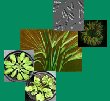| Sikolia, S; Beck, E; Onyango, JC: Carbon dioxide compensation points of some dicots of the centrospermeae species and their ecological implications for agroforestry, I. J. Bot.(5), 67-75 (2009), doi:10.3923/ijb.2009.67.75 | |
| Abstract: The present studies on carbon dioxide compensation point (Γ) considered species from tropical semi-arid, snowline and saline ecosystems. The aim of the study was to establish the ecological range of the CO2 compensation point of species in the semi-arid/arid, snowline/or saline conditions. Secondly, to determine the effect of biomass on the rate of carbon dioxide assimilation in relation to the ecological efficiency of the C3 and C4 photosynthetic pathways. Four and six-seven week old plants were used to assimilate carbon dioxide in the gas chamber until a constant reading was attained by Infra Red Gas Analyzer (IRGA). The carbon dioxide uptake concentrations (assimilations) were continuously measured by pumping a stream of the air through a closed gas tight, circuit with IRGA while temperature and light intensity and previous growth conditions were maintained constant. The dry weight of the plant was measured using a digital balance after the experiment. The CO2 compensation points of the C4 plants vary between 8-20 ppm. The CO2 compensation points of the C3 plants vary between 40-60 ppm. The age and biomass of the plant influenced the rate of carbon dioxide assimilation in the C4 species and C3 species. The C4 plant attained the CO2 compensation point faster than C3 plant under the same physiological conditions. The C4 plant photosynthesized below 40 ppm of carbon dioxide concentration. The C3 plant ceased carbon dioxide assimilation below 40 ppm of carbon dioxide concentration. Thus, an ideal ecological canopy set-up should consist of a C4 over storey and a C3 under storey for efficient photosynthetic performance and yield. Potential C4 overstorey species including Amaranthus species and Kochia scoparia, should be intercropped with potential C3 understorey species like Chenopodium album and Phytolaca dioica by farmers and horticulturalists in Agriculture. The intercropping practice is economical, viable and apt in agroforestry systems, especially in the semi-arid and saline conditions socialized by nomadic tribes in Kenya. Perkerra irrigation project can act as satellite agroforestry research station, including Kerio valley and Turkana regions. |

Letzte Änderung 08.07.2020

